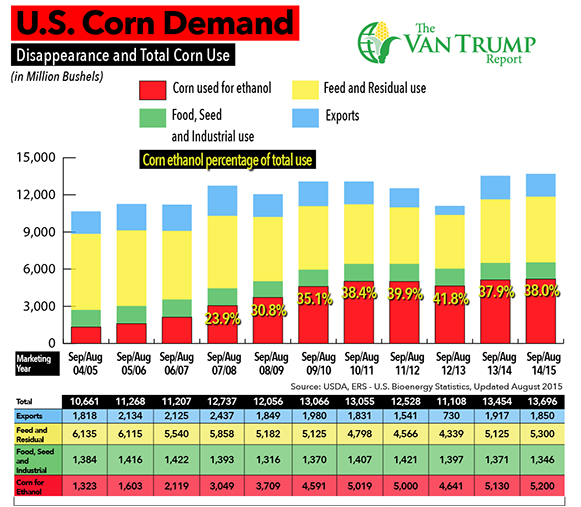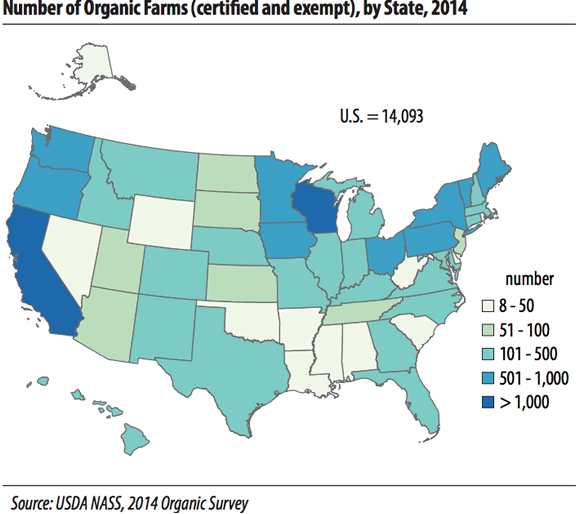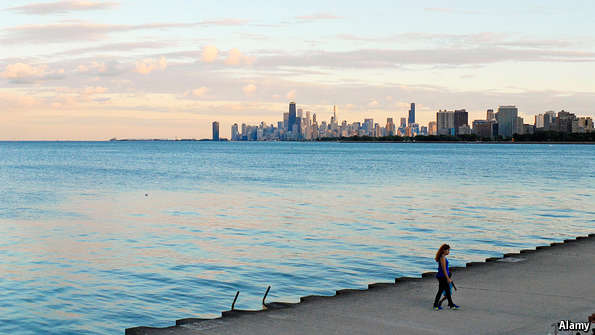Despite Growing Demand, Organic Acreage Is Shrinking
The USDA recently released some interesting data about the state of the organic industry. It’s been well documented that demand has been rising over the past few years. Last year, more than 14,000 farms sold $5.5 billion in organic products, up +72% since the last survey conducted in 2008. Despite the seemingly booming demand though, both the number of farms and the amount of land dedicated to organic production has actually declined. There were 14,093 organic farms in the United States last year, accounting for 3.6 million acres, with another 122,175 acres in the process of becoming organic, according to the latest National Agriculture Statistics Survey. However, in 2008 there were 14,540 organic farms making up 4 million acres with another 128,476 acres going through transition. It’s not a huge reduction, but it’s definitely puzzling considering the growing size of the market. Organic sales are mostly concentrated in fruits and vegetables, along with milk and eggs. Meanwhile, producers of organic meats are struggling to boost production even as big retailers such as Target and Costco Wholesale seek to expand the number of products they offer. With about 90% of U.S. corn and soybeans production being genetically modified, those seeking organic feed are forced to turn to imports. Soybeans are the second-largest U.S. organic import following coffee, totaling $184 million last year, while organic corn imports totaled $35.7 million. Those total’s are pretty paltry in comparison to the combined $92.7 billion value of those crops grown in the U.S. last year, but there is obviously a huge supply and demand gap within our borders. The biggest problem for grain producers that may be considering switching to organic is the certification process – it’s a three year process to transition land from traditional to organic, meaning that land basically produces no revenue during that time. It will be interesting to see if falling commodity prices incentivize farmers to give organics a try. In some areas I hear organic corn has actually been trading for more than double the price of traditional corn. Whether that price incentive remains by the time you wrap up the three year transition is a big gamble.
From rustbelt to bluebelt
Could water be the Midwest’s ticket to economic rebirth?
CYCLING to and from work along the shores of Lake Michigan in the summer months, marvelling at the brilliant turquoise water in the morning and shades of pink, purple and deep blue in the evening, ever-varying with wind and weather, is a treat for Chicagoans. The lake makes a majestic backdrop for the city’s splendid architecture, and its beaches are a meeting place for people of all classes and colors in this still segregated place.
Lake Michigan and the four other lakes in the region are also the most important asset for Chicago’s home state, Illinois, and the seven other American states that border the Great Lakes, according to a vocal school of thought in the Midwest. “We wrecked our water by leading the industrial revolution,” says John Austin, director of the Michigan Economic Centre. “Now we have to reclaim it to secure our future.”
The Midwest’s industrial boom was carried along by water. It was an important input for the car industry in Detroit, for breweries in Milwaukee, steelmakers in Gary, paper manufacturers in Muskegon and makers of furniture in Grand Rapids. Industries and communities flocked to river- and lakefronts (Chicago had both). Water lubricated the new activity—and helped transport raw materials and finished wares. The new industrialists could use water at scale—and they abused it, pouring toxic waste into the sea-like lakes.
For a long time Midwesterners ignored the damage done. It took fires on the Buffalo, Rouge, Detroit and Chicago rivers, fuelled by thick, oily sludge in the lakes and their arteries, for that to change. In 2010 the Great Lakes Restoration Initiative was born to improve water quality, clean up shorelines and restore habitats and species. Five years later, on July 28th, the Environmental Protection Agency (EPA) submitted a progress report on the initiative to Congress. It says that five areas of concern have been cleaned up, 148,000 acres of wetlands, islands and coastal habitat restored, phosphorus run-off from farms reduced and invasive species rebuffed.
More needs to be done to clean up the lakes and rivers, but attention is now shifting from conservation to the economic uses of abundant water. The Midwest has more than 20% of the world’s (and 80% of America’s) freshwater supply. It is trying to position itself as a centre for research and development for water-related technologies. Milwaukee’s Water Council, which promotes investment, research and jobs in water technology, wants the region to be a wetter version of Silicon Valley. Its Global Water Centre is an incubator for water-based companies. The School of Freshwater Sciences at the University of Wisconsin’s Milwaukee branch is one of only three such freshwater schools in the world (the other two are in the Netherlands and in Singapore). Milwaukee calls itself the “World Water Hub”. Delegations of visitors from around the world seem to believe it.
Curiously, given the abundance of the stuff, several corporate pioneers in water conservation and technology have their […]
NASA Will Make Pluto Flyby This Morning after 3-Billion Mile Journey
New Horizons spacecraft will sweep past Pluto this morning within just 7,800 miles of the previously unexplored world. New Horizons has traveled 3 billion miles over 9½ years to get to this historic point. The fastest spacecraft ever launched, it carries the most powerful suite of science instruments ever sent on a scouting and reconnaissance mission of a new, unfamiliar world. Read more at Space.com, where you can also see some of the images already sent back from New Horizons and get the latest news on the Pluto Flyby.
2015 Southern Feed & Grain Convention Forms
All forms for the 2015 SFGA Convention are now online. Download All Forms now or visit the Events Section of this website for individual forms.



